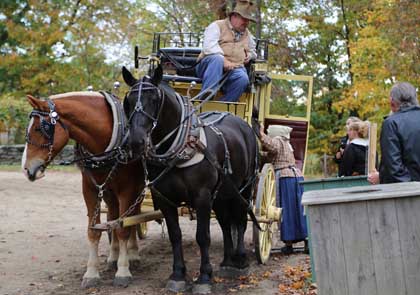
The “good ole days” sound safe and comforting and uncomplicated. Yet life in the early nineteenth century lacked most of the conveniences that we take for granted. Need some bread for supper? Well, you better get ready to harvest your wheat with your hand sickle, thrash the dried bundles (can you feel the chaff itching on your sweaty skin?), grind the wheat with your little hand mill (or take it to the local mill), get the bread oven heated by feeding it with the wood you had previously cut and split, knead the huge amount of bread dough (remember you have to take care of a big family), and then bake for hours. Every loaf of bread meant an investment of days and days of accumulated work. By the way: meat in any shape was the most important staple for the average family in early nineteenth century New England and numerous flies were the most common visitors in any kitchen at the time.![WHEELS OF PROGRESS: Horse-drawn coaches were typical means of transport in the 1830s, connecting far-flung towns and villages to the major cities. [PHOTO: GK]](https://adventistreview.org/wp-content/uploads/2022/01/13-10-17-2.jpg)
Adventist pioneers loved to communicate the message by giving out (or sending) printed material. When I think of printed material, I see the laser printer in my office, which spits out enormous amounts of nicely designed (even color-printed) papers in seconds—never mind the huge commercial printing presses that run six days a week at the Review and Herald Publishing Association in Hagerstown, Maryland.
Do you know how long it took a printer in nineteenth century New England to handprint an eight-page pamphlet with a print run of 1,000 copies (like the first four issues of Present Truth, the forerunner of the Adventist Review, whose printing cost $64.50)? The most laborious part was setting the type and proofing the type, which would take more than a day for a multi-page pamphlet. The actual printing would take another day or two, after which the print sheets would have to be dried before they had to be cut to size and folded together. Depending on the season of year and temperatures the drying of the printed sheets could take days. Oh, did I mention that printing wasn’t cheap? What a time-consuming and expensive process—and all because someone wanted to share the good news of Jesus’ soon coming with friends and neighbors!
After having spent 3 hours (too short) at the Old Sturbridge Village in Sturbridge, Massachusetts, I have a new admiration for those hard-working people living in the early nineteenth century. Yet, despite their long days they made time to focus on first things with eternal dividends. There is something to be learned here.